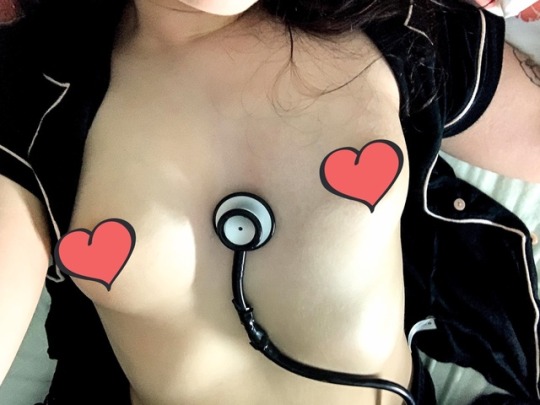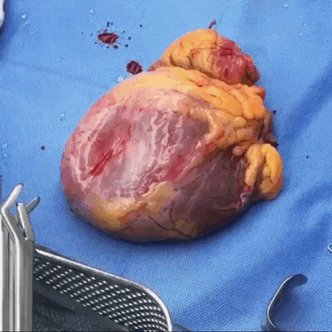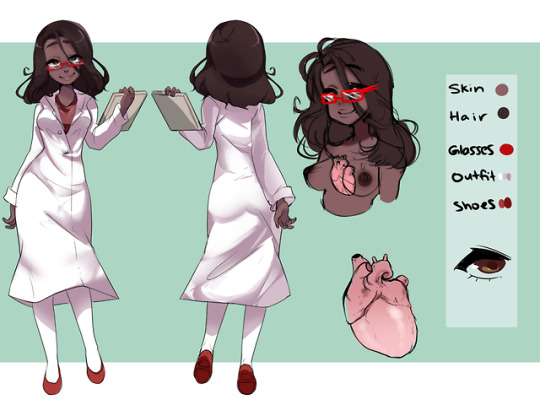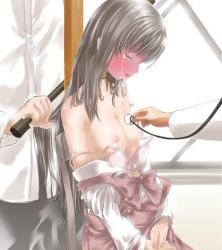Text
She thinks she's getting a routine checkup.. unknowingly that the doctor is actually seeing how healthy her heart and lungs are ... he tells her she's in top shape but the fake vitamins hes giving her. She'll surely never leave the doctors doctor's office nor will her body leave the room with her heart still beating in her chest

115 notes
·
View notes
Text
Vital Signs
I’m writing a MacGyver fic right now that relies heavily on vital signs to show change in a character’s condition. In the comments, someone (I don’t know your tumblr, beautifullights!) expressed they wished they knew more about how to read vitals. Here you go!

What are Vital Signs?
Vital signs are objective measures of how well critical body systems are functioning at a given moment. The classic vital signs include Heart Rate, Respiratory Rate, Blood Pressure, and Temperature (and recently Oxygen Saturation). A single set of vital signs may indicate a need for an emergency intervention (by identifying a critical vital sign), while multiple sets taken over time can track how the body is reacting to different conditions or interventions.
This post goes over the common vital signs themselves, and generally what they would mean for an otherwise healthy adult. Note that children and those with chronic illnesses may have different vital signs as their baseline.
Heart Rate (HR)
Heart Rate is the number of heartbeats in one minute.
What it Measures: The body’s demand for blood. Blood carries oxygen and nutrients to cells, while carrying metabolic waste products like carbon dioxide away to other organs for disposal. A higher heart rate means there is a higher demand for this process, while a lower heart rate means there’s a lower demand for this process.
Normal: 60-100 (for an adult at rest).
Critical: Heart rate that is critically high (>130 at rest) may make the heart unable to fill with blood completely between beats, while a heart rate that is critically low (<40) may prevent the heart from moving enough blood to support life.
Ways to Measure:
Via ECG/EKG
Counting beats while listening through a stethoscope
Counting a pulse (most commonly in the neck or wrist)
Causes of Change: Stress, pain, stimulants, dehydration, fever, and physical activity increase heart rate, while beta blockers, physical fitness, sleep, and relaxation lower it
Respiratory Rate (RR)
Respiratory Rate is the number of breaths in a minute
What it Measures: The body’s gas exchange needs. The lungs and the act of breathing regulate oxygen and carbon dioxide levels. Essentially, more breathing means the body needs more oxygen or less carbon dioxide, while less breathing means the body needs less oxygen or more carbon dioxide. Breathing pattern also impacts these things.
Normal: 12-20 (for an adult at rest)
Critical: RR that is critically high (>30 at rest) may cause CO2 levels to drop to dangerous levels (we need some CO2 to help regulate the body’s pH, without it, we become too alkaline), while RR that is critically low (<8 at rest) may cause dangerously low levels of oxygen (O2 is required for cells to make and use energy) or dangerously high levels of CO2.
Ways to Measure:
Counting a person’s chest rise and fall
With an impedance band around the person’s chest (hospital)
Sensor in a special kind of nasal cannula (hospital)
Causes of Change: Stress, stimulants, fever, pain, physical activity, and high acidity levels increase RR, while depressant drugs (most notably opiates), sleep, and low CO2 levels decrease it
Blood Pressure (BP)
Blood Pressure is a measure of the highest and lowest pressures exerted on the inside of an artery during a heartbeat
What it measures: How successfully the cardiovascular system is getting blood where it needs to go. Blood pressure must be high enough that all cells have access to blood, while not so high that it causes damage to blood vessels.
Normal: 100-120 (top number or systolic) over 60-80 (bottom number or diastolic)
Critical: A blood pressure that is critically low (<90/<50) could mean enough blood isn’t circulating to the brain or vital organs, while a blood pressure that is too high (>160/>90) may greatly increase the risk of a stroke or heart attack.
Ways to Measure:
With a blood pressure cuff (with a stethoscope or by inflating the cuff until you can’t feel the pulse below it (roughly measures the top number only)).
With an arterial BP catheter (basically an IV in an artery that connects to a sensor that measures BP continuously in an ICU setting)
Or, if you’re desperate and have no equipment, if you can feel a pulse in the wrist, the person’s BP is (roughly) above 90 for the top number
Causes of Change: Stress, pain, kidney problems, and stimulants increase BP, while dehydration/bleeding, beta blockers, IV opioids, high CO2 levels, and heart failure lower it
Temperature (Temp)
Temperature is literally the temperature inside the body
What it measures: how well the body is regulating its temperature. The body’s metabolism is designed to operate at 98.6F, so the body constantly fights to stay at that temperature by sweating and dilating surface blood vessels to shed heat and shivering and constricting surface blood vessels to create and conserve it.
Normal: 98.6F or 37C.
Critical: Critically high (>104F/40C) or low (<92F/34C) temperatures cause changes in the rate of vital chemical reactions, which can become dangerous (low temps are more dangerous for the heart, while high temps are more dangerous to the brain).
Ways to measure:
With a digital or analogue thermometer in the mouth, armpit, groin, or rectum
With an infrared thermometer in the ear or across the temporal artery
Through a sensor in special urinary catheters (hospital)
Roughly by feeling your own forehead while feeling the patient’s
Causes of Change: Brain damage (to portion of brain that sets temperature), fever, dehydration (inability to sweat), physical activity and overwhelming heat increase temperature, while exhaustion (inability to shiver), sleep, and overwhelming cold decrease temperature.
Oxygen Saturation (SPO2)
The percentage of hemoglobin molecules in the blood are carrying oxygen molecules.
What it Measures: How effective the lungs are being at transferring oxygen from the air to the blood. Hemoglobin is the protein in blood that carries oxygen to the tissues. It picks up oxygen while moving through tiny blood vessels (capillaries) in the lungs, and drops it off in body tissues. SPO2 measures what percentage of the present hemoglobin molecules are actually carrying oxygen when they reach the tissues.
Normal: 92-100%
Critical: at a sustained SPO2 <85%, body tissues begin to be starved of oxygen (though some people (like those with COPD or severe asthma) have adapted to living at this level no problem)
Ways to measure:
By percentage with a pulse oximeter (a machine that calculates oxygen saturation by comparing the amount of red light (blocked by oxygenated Hb) to the amount of infrared light (not as blocked by oxygenated Hb) that can pass through tissue)
Skin color- pink skin for light skinned folks or gums for dark-skinned folks represents adequate oxygen saturation, while grey/blue skin/gums represents inadequate oxygen saturation
Causes of change: failing to breath enough, blockage in lungs,
Note on pulse oximeters: pulse oximeters can be confused by carbon monoxide, a much more useless molecule that hemoglobin also sometimes picks up instead of oxygen. Someone with carbon monoxide poisoning might read at 100% even though actually starved for oxygen. Also, someone who is really low on hemoglobin (say, from blood loss) might read at 100% because all present hemoglobin is filled with oxygen, but overall does not have enough oxygen moving through their system to support life.
382 notes
·
View notes
Text

The beating of my little heart, pumping life to my body, taps against my breast as it fills and contracts.
Ba-dump, ba-dump, ba-dump
Quickly it beats, pushing the stethoscope up and down in a rhythmic motion, the pale skin of my chest twitching as my vital little organ works hard to provide me life.
It beats loudly, so loudly because it wants someone to listen. Hear it’s song, each valve and squeeze, each skip and misstep. Listen to everything my heart has to say.
https://drive.google.com/file/d/1yWctOvg2YyvvpY4imYidOujQVxyJLbgK/view?usp=drivesdk
376 notes
·
View notes
Video
youtube
Well she’s got a fighter’s heart. I love those beats.
85 notes
·
View notes
Text
Internal craving...
I want a hand on my exposed heart.... I want to feel it throbbing and pumping against strong fingers.... I want to feel it accelerating, fighting against a tightening grip....
I want it to be manually forced .... his hand rhythmically squeezing and releasing, forcing artificial beats from my frightened little pump....
I want to literally arrest right there in his hand.... my heart cradled gently as it ceases to beat.... And then I want that same hand to gently caress and massage my little heart back to life.....
Could there be any sexier form of dominance?? 😍😍😍 (And now I'm wet as fuck and touching myself after writing that....)

197 notes
·
View notes
Text


The harvest was a success! I don’t think this heart will have any issues being restarted in its new chest.
67 notes
·
View notes
Text
Heartbeats are like beautiful endless songs ♥️
~Badum badum badum badum~
16 notes
·
View notes
Photo

THanks again, Lewdishsnail ;__;
Dr. Orisa is one of the three main protagonists in the story I was talking about in the first reference.
She is a general doctor and thoracic surgeon who follows Nekimo in her secession from her sister’s kingdom. Dr. Orisa strongly opposes Nekimo’s intention to start war against their tribal neighbors, though she feels she can mitigate the damages, or at best, change the young princess’ mind if she follows her and gains her trust.
Orisa has spent a few years working with their neighbors. She is loved by their people who allow her to roam freely in the village which is heavily guarded and blocked off the world. Such is why it comes as a shock to everyone when they see her side with Nekimo.
https://onouwu.tumblr.com/post/170650932603/thank-you <-previous character
77 notes
·
View notes
Photo

I so wish I was at her place. Being garroted and listened like that would be absolutely awesome.
Source : no idea, someone sent that to me and he doesn’t know either. Not mine for sure.
159 notes
·
View notes
Text
198 notes
·
View notes
Text
I want my heart tortured and cut out still beating.. I wanna feel my heart beating in someone's hand
44 notes
·
View notes



